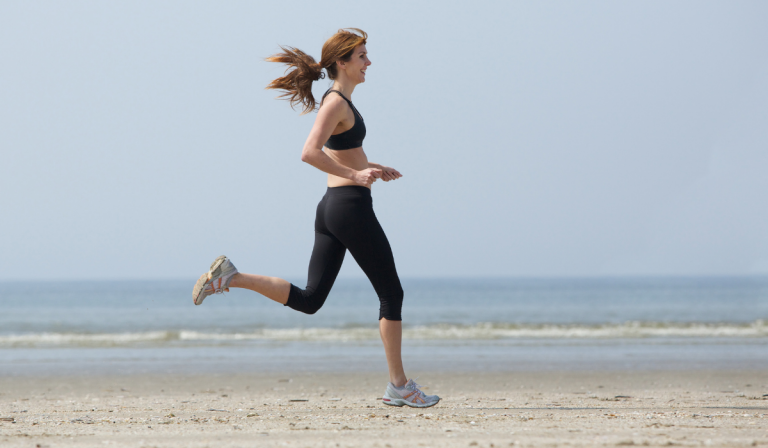What Is a Good Vertical Oscillation for Running?
Vertical oscillation measures how much a runner moves vertically with each stride. In other words, vertical oscillation tells us how much energy we spend to move the body up and back to the ground.
Knowing your vertical oscillation is essential because it allows you to take the steps necessary to improve it.
What is a good vertical oscillation for running?
The ideal vertical oscillation range for running is around 5-10 cm. Higher vertical oscillation often leads to inefficiency while contributing nothing to your forward motion. On the other hand, when your vertical oscillation is too low, it results in a lack of pace and power.

So, now that we know the ideal vertical oscillation for running, how does it affect a runner’s performance? Can I use vertical oscillation to improve as a runner?
We provide answers to these questions and much more in this article.
What Is a Good Vertical Oscillation for Running?
As we already mentioned, the ideal vertical oscillation range for running lies between 5 and 10 cm.
If your vertical oscillation is high, it indicates a higher impact when you land. Unfortunately, this can significantly increase the risk of sustaining an injury.
A low vertical oscillation signifies you spend more time on the ground or have short strides. Either way, low vertical oscillation can affect your running performance.
Once you become aware of your vertical oscillation, keeping it balanced can help you improve your overall performance.
How Does High Vertical Oscillation Affect Running Performance?
If your oscillation is too high, you’ll feel a jarring bounce in your knees and back. High vertical oscillation can cause injuries like fractures and knee pain.

You can reduce your vertical oscillation by leaning your body forward (but don’t slouch).
Once you lower your vertical oscillation, you can efficiently transfer more energy towards moving forward. You also reduce the impact of each stride.
As a result, you run faster while using less energy.
What Are the Causes of Higher Vertical Oscillation?
Below are some reasons for higher vertical oscillation:
- Running upright – If you don’t lean forward enough, your vertical oscillation increases.
- Timing – If you push off the ground too early (not letting your foot fully absorb the impact before pushing off again), your oscillation will be too high.
- Overextending knees and ankles – If you overextend your knees and ankles, your vertical oscillation increases.

What Are the Causes of Low Vertical Oscillation?
Beginners tend to have a lower vertical oscillation.
Here are some reasons for low vertical oscillation:
- Lacking in fitness – If a runner isn’t fit enough, they’ll tend to shuffle their legs faster rather than push off the ground with the right amount of force.
- Lacking in strength – a runner with weak glutes will struggle to achieve an optimal vertical oscillation.
7 Workouts for Minimizing Vertical Oscillation While Running
Here are some drills and workouts to help you minimize your vertical oscillation while running.
Fall-to-Run Drill
This drill trains you how lean forward without bending your hips.
Stand tall, then begin to lean forward from your ankles. When you feel like you’re going to fall, start running.

Strides
Incorporating strides into your training routine can help you improve your vertical oscillation.
Strides can help runners improve their running form and the mechanics required for effective strides. Strides depict running movements such as knee drive and hip extension. You typically do strides after an easy run.
To perform strides, run fast for 20-30 seconds at 80% capacity. Ensure you maintain a good running form as you push off the ground with each stride.
After each stride, recover for 20-30 seconds and go again. You can perform 5-8 strides after an easy run.
Uphill Runs
A steep uphill run helps us train our muscles and build the strength required to run.
Run up a steep hill for 20-30 seconds at maximum capacity. Then walk or jog downhill.
If you train with a treadmill, use a grade higher than 4%.

Single-Leg Hops
Single-leg hops improve leg strength and springiness and rectify strength imbalances.
A single-leg hop looks much like how you would move if you could only use one leg.
Put all your weight on one leg and bend your other leg at the knee. Then bend the leg supporting you just a little (a quarter of a squat) and start hopping with that leg. Repeat the exercise with the other leg.
Walking Lunges
To perform this drill, imagine you are walking under a low ceiling. So, to advance, you need to lower yourself and try to maintain a constant speed. Ensure your hands are free throughout this workout.
Walking With a Low-High Obstacle
To perform this drill, you will walk and imagine you have two sets of obstacles: high and low obstacles. You go under the low obstacles and climb over the high obstacles.
When you go under the low obstacles, ensure you lower yourself as much as possible.

Wall Drills
Stand a few feet from a wall so that when you place your hands on the wall at shoulder height, your elbows are straight. Position yourself so that your body leans forward in a straight line.
Then:
- Stand on the toes of one foot and push the knee of the other leg towards the wall.
- Keep the raised knee in that position for about 10-20 seconds before returning your leg to the ground.
- Ensure you do not drop your hips while you are in this position.
- Repeat the drill with your other leg.
Final Take
You can be an efficient runner with a vertical oscillation of 5 to 10 cm. But if your vertical oscillation is too low, your runs may lack pace and power. Then if they go too high, you may expend more energy than necessary. So, as much as you can, maintain an intermediate vertical oscillation.
Resources:
- https://blog.cipherskin.com/insights/vertical-oscillation-and-running-performance
- https://www.technogym.com/us/newsroom/vertical-oscillation-exercises-running/
- https://matthewboydphysio.com/improve-running-performance-reducing-vertical-oscillation/
- https://innersport.com/archives/4011
- https://geeksonfeet.com/run/optimizing-vertical-oscillation/
- https://sporttracks.mobi/blog/what-is-vertical-oscillation
- https://geeksonfeet.com/run/stridetraining/
- https://geeksonfeet.com/run/plyo/







